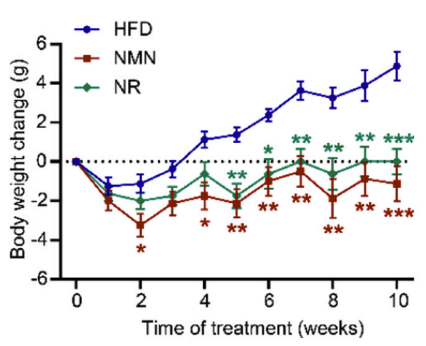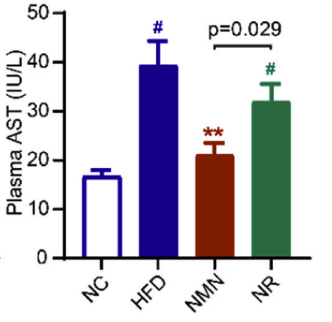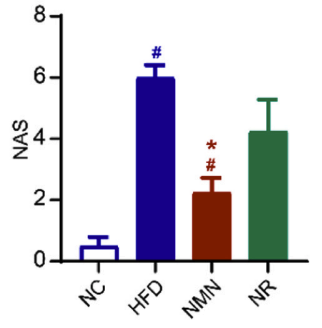A recent study investigated the effects of oral NMN and NR supplementation in mice with nonalcoholic fatty liver disease (NAFLD).
Key Points
NMN and NR provided benefits in mice on a high-fat diet (HFD), but NMN offered more significant protection against NAFLD:
- Both NMN and NR prevented weight gain and improved blood sugar and fat regulation
- NR was less effective than NMN for preventing liver weight gain
- Markers of liver injury were significantly lower in the NMN group, but not in the NR group
- NMN significantly improved a key NAFLD score (NAS)
Study Evaluates NMN and NR in Mice with NAFLD
NAFLD model construction:
- 32 male mice were randomly divided into 2 initial groups for 16 weeks:
- Negative Control (NC) Group (n = 8): Normal chow diet (CD) and water
- NAFLD Group (n = 24): High-fat diet (HFD) and water
After 16 Weeks:
- Mice with NAFLD were further divided into three groups:
- HFD Group (n = 8): Vehicle Solution (oral gavage), HFD, water
- NMN Group (n = 8): NMN Solution (oral gavage, 500 mg/kg), HFD, water
- NR Group (n = 8): NR Solution (oral gavage, 500 mg/kg), HFD, water
- Mice in the NC Group began receiving water (oral gavage) in addition to normal CD and water
The study groups (NC, HFD, NMN, NR) received their respective treatments via oral gavage for 10 weeks.
Obesity, Blood Sugar, and Fat Regulation
Both NMN and NR prevented body weight gain and size compared to the high-fat diet (HFD) group.

This chart shows that the HFD group (blue) experienced significant weight gain over 10 weeks, while the NMN (red) and NR (green) groups did not.
NMN and NR improved measures of insulin resistance, but only NMN improved fasting blood glucose (sugar) levels.
“NMN, instead of NR, lowered fasting glucose levels compared with the HFD group.”
Some aspects of fat metabolism were also regulated by NMN and NR, including HFD-induced elevations in blood cholesterol and fat cell size.
“We found that both NMN and NR significantly restrained body weight gain and lowered plasma insulin levels, and NMN supplementation also markedly reduced fasting glucose levels and improved insulin resistance in HFD mice.”
Liver Weight Gain and Fat Accumulation Prevented By NMN
NMN provided superior protection in the liver across several measures.
Liver Weight: NMN prevented liver weight gain caused by a HFD, but NR did not.
“NMN, but not NR supplementation, clearly alleviated HFD-induced liver weight gain.”
Liver Fat Content: NMN and NR reduced the fat content and pale discoloration of the liver caused by a HFD. However, microscopic examination revealed that NMN had a more pronounced effect.
“NMN supplementation observably reduced liver lipids, while NR supplementation slightly ameliorated liver lipids compared to the HFD group.”
NMN Protected Against Liver Injury Caused by HFD
Liver Injury Markers: Markers of liver injury in the plasma were significantly reduced in mice receiving NMN, but remained elevated in the NR group.
You can see from the graph that the NMN group (red) had significantly lower levels of AST (a marker of liver injury) compared to both the NR group (green) and the HFD group (blue).
“NMN administration alleviated HFD-induced liver injury, while NR administration had no therapeutic effect on HFD-induced liver dysfunction.”

NMN Outperformed NR in Liver Protection
NAFLD activity score (NAS): The overall lNAFLD activity score was significantly lower in the NMN group. In contrast, the NR group had scores close to those of the HFD group.

This figure shows the NAS scores for the NMN group (red) are significantly lower compared to the HFD group (blue), while the scores for the NR group (green) did not show a significant difference from the HFD group.
“Combined with the above results, we draw a conclusion that NMN supplementation effectively alleviated HFD-induced NAFLD in mice.”
Oxidative Stress: Interestingly, NMN and NR increased liver antioxidant levels and reduced a marker of free radical damage called MDA.
NMN Reduced Scarring in the Liver
Supplementation with both NMN and NR helped reduce liver scarring caused by the HFD. However, NMN was more effective than NR:
- Microscopic Evaluation: Stained liver tissues showed NMN significantly reduced signs liver damage, unlike NR
- Marker of Liver Scarring: NMN, but not NR, reduced the levels of hydroxyproline, a marker of liver scarring
Conclusion
NMN and NR supplementation offered benefits for mice on a HFD, preventing weight gain and improving blood sugar and fat regulation.
However, NMN emerged as the more effective strategy for NAFLD.
“The beneficial effect of NMN supplementation was more potent than that of NR supplementation.”
Only NMN significantly reduced liver weight, restored injury markers, and lowered a scoring system (NAS) that reflects overall liver health in these mice.
